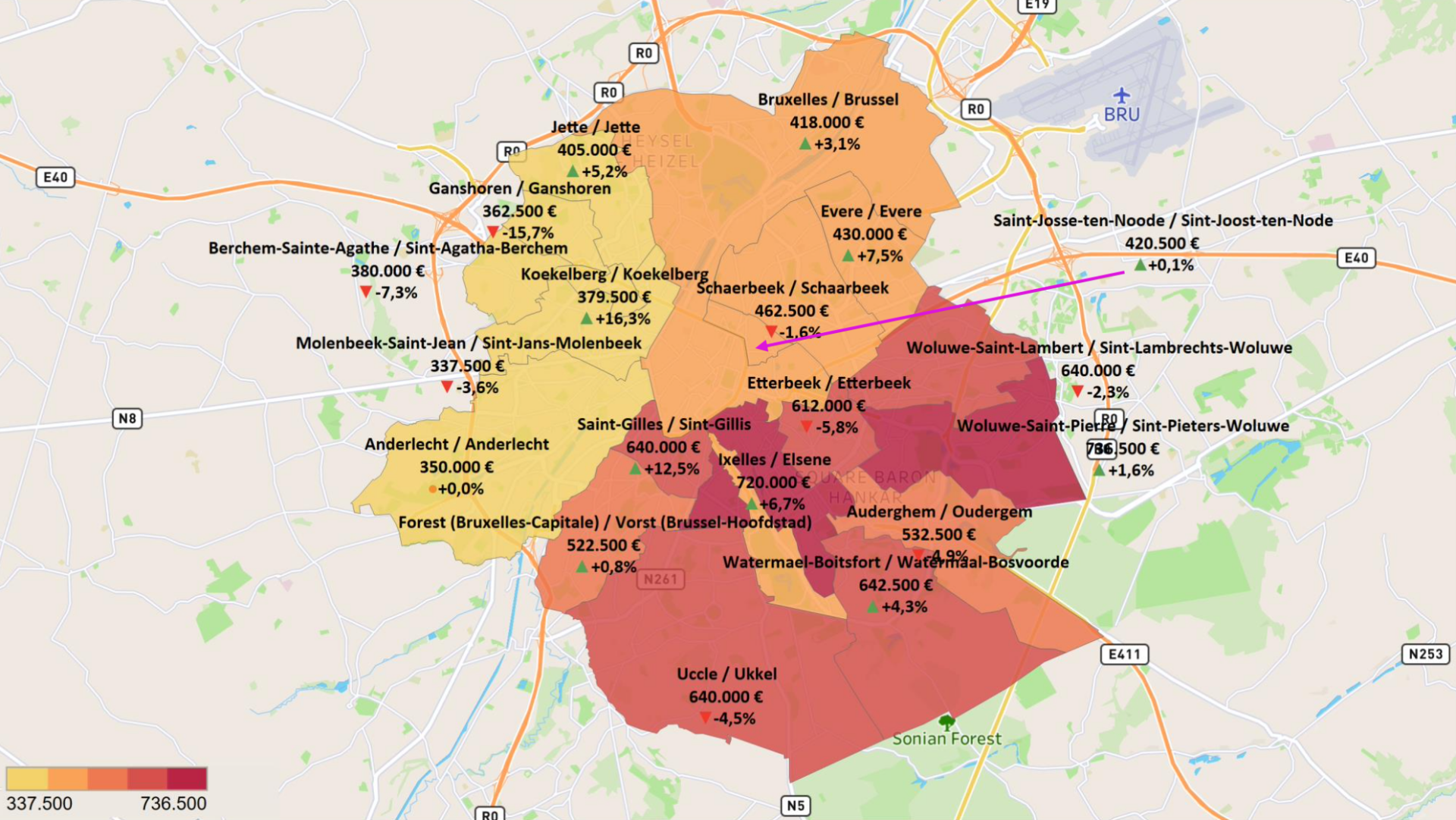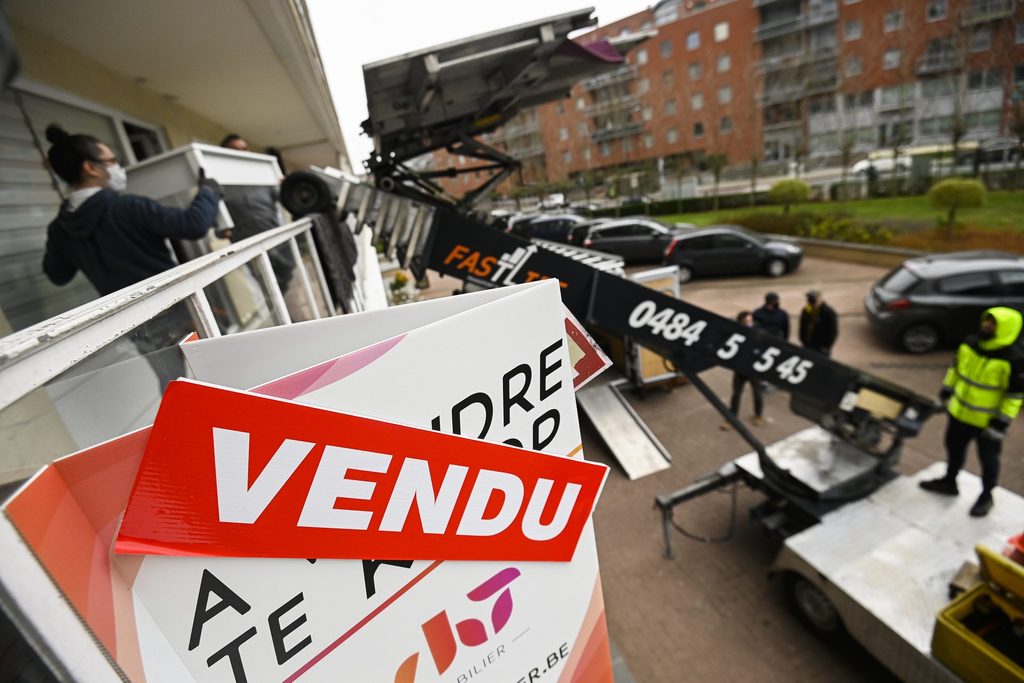While the entire region is the most expensive in the country for buying property, there are large discrepancies in Brussels' housing market. The difference between the lowest and highest median price was around €400,000 in 2023.
Interest rate rises and the general economic situation in 2023 caused the property market in Belgium to cool down, with Brussels recording a 14.2% drop in sales. This had a slight impact on prices (taking inflation into account, the price decreased by 1.1%), but the region remains the most expensive in Belgium. Compared to 2019, house prices rose by 25% and apartments became one-fifth more expensive.
The median price of a house in Belgium (which is less affected by the most expensive properties than the average price) was €289,000, while in Brussels this was as high as €495,000. Every Brussels commune has a median higher than the national median. This can partly be explained by the small housing stock in the region (35% compared to around 75% nationally).
However, when zooming into the communes, there are large price differences, the Federation of Notaries (Fednot) highlighted. Seven of the 19 communes are in the top 10 of the most expensive places to live in Belgium, while the price in others is much lower.
"The housing market in Brussels is not homogeneous and cannot be seen as a regional market in itself," Fednot's Jean Martroye said. "We have to instead view it as three zones, each with comparable prices because the ranges are so different." The Charleroi-Brussels Canal forms this clear border in terms of price.
Costly south-east
Median prices were highest in the south and southeast of the canal. Here, the price was higher than that of the entire region in every municipality. The most expensive commune was once again Woluwe-Saint-Pierre, with a median price of €736,000. This is also the highest house price in the country.
Ixelles (€ 720,000), Watermael-Boitsfort (€642,500), Woluwe-Saint-Lambert, Saint-Gilles and Uccle (all €640,000), which are located in this zone, made up the rest of the national top five. Price-wise the municipalities of Etterbeek (€612,000), Auderghem (€532,500) and Forest can be pinned between this zone and the second-cheapest (€522,500).

The map shows the various zones, with the yellow zone to the left of the canal being the cheapest. Credit: Fednot
In the geographical centre and north of the Brussels-Capital Region, still located to the east of the canal, the median price was between €418,000 and €462,500. This zone includes the City of Brussels, Evere, Schaerbeek and Saint-Josse-ten-Noode.
The lowest median price for a house (€405,000 in 2023) can be found to the west and northwest of the canal. This zone includes the communes of Anderlecht, Koekelberg, Berchem-Sainte-Agathe, Ganshoren, Jette and Molenbeek-Saint-Jean, which with a median price of €337,500 is the cheapest Brussels municipality. The biggest price drop was observed in Ganshoren (-15.7% or €67,500).
More flats, stable prices
The much-larger apartment stock in the Belgian capital's region (65% of all properties) is also reflected in the price differences. The median price of a flat in Brussels (€250,000) is much more comparable to that on the national level (€238,000) and in Flanders (€248,400).
As with houses, the municipalities of the Brussels Region can be divided into three zones according to the median price of a flat. Again, the cheapest flats are located in the west/north-west of the Brussels Region (prices range from €194,250 in Anderlecht to €220,000 in Koekelberg), but also in Saint-Josse-ten-Noode (€217,500). "Here, all median prices are lower than the national median price for a flat," Martroye noted.

An apartment block. Credit: Belga
Except for Watermael-Boitsfort (€266,000), the most expensive flats are located in the south and southeast of the region. Prices here range from €305,000 in Woluwe-Saint-Lambert to €344,500 in Woluwe-Saint-Pierre, which is also the most expensive commune for flats in Brussels. Nationally, it only ranks in 12th place.
In the central axis of the region lie the flats of which the price is between the highest and lowest prices. This zone includes the City of Brussels (€245,000), Evere (€236,000), Schaerbeek (€248,500), Saint-Gilles (€283,000), Forest (€267,000) and Etterbeek (€285,000).
The biggest price increase was observed in Koekelberg (+10%) while the largest drop in cost was seen in Woluwe-Saint-Lambert (-6.2%). Meanwhile, the share of new flats was 3.7%, compared to 96.3% for existing flats, making the capital region the one with the lowest share of new flats. This is large because Brussels is more densely built, meaning there is little space for new apartment complexes.
Expectations for 2024
The energy efficiency of a house or flat has already become an increasingly important factor for buyers and Martroye expects this trend will continue. An energy performance certificate (EPC) is drawn up every time a property is sold, indicating its energy efficiency with a score ranging from A+ to G.
The share of energy-efficient houses increased in 2023, but remains much lower in Brussels (32.8% compared to 69.3% in Flanders and 41% in Wallonia). The price of houses with a lower score has already started to decrease. "The price evolution caused by the EPC values is already being observed and it remains to be seen whether this will cause further decreases," he told The Brussels Times.
Related News
- Poverty in Brussels: One in ten suffers from severe housing deprivation
- Renting in Brussels becomes far less affordable as prices reach record high
If the cooling down of the market persists and there is less demand, giving buyers more bargaining power, this could see prices fall, especially for properties with a lower EPC rate which are harder to sell. However, Martroye stressed that the elections also play a role. The next government may make an even bigger push with premiums and make it easier for people to make the necessary renovations to improve their scores.
The evolution of house prices also depends on inflation. If this rises again, this could affect mortgage rates and further deter people from buying a house.

